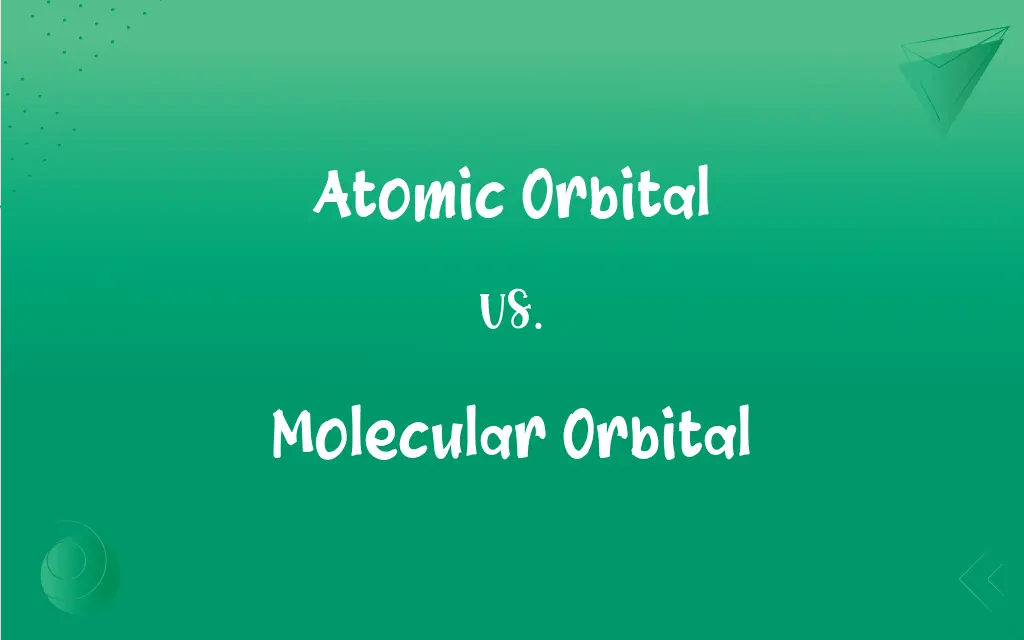Atomic Orbital vs. Molecular Orbital: What's the Difference?
Edited by Janet White || By Harlon Moss || Updated on October 18, 2023
An atomic orbital refers to the probability space where an electron resides around a single atom, while a molecular orbital pertains to the electron's probability space in a molecule.

Key Differences
Atomic orbitals are fundamental concepts in quantum mechanics, representing regions around an individual atom where electrons are most likely to be found. These orbitals have specific shapes and energies associated with them. On the other hand, molecular orbitals arise when atoms combine to form molecules, resulting in the overlap of their atomic orbitals, creating new electron probability spaces for the entire molecule.
When two atoms approach each other, their atomic orbitals can interact. Depending on the nature of this interaction, molecular orbitals are formed, which can be of bonding or antibonding character. Atomic orbitals, in contrast, are solely associated with individual atoms and do not account for the interactions between atoms in a molecule.
It's vital to understand that while atomic orbitals are a foundational concept describing electron distributions around isolated atoms, molecular orbitals provide a more comprehensive picture of how electrons are distributed in molecules. This distinction between atomic and molecular orbitals is crucial in understanding chemical bonding, reactivity, and molecular properties.
Electron configuration in atomic orbitals is described by the principles of quantum mechanics, using labels like s, p, d, and f. In molecular orbitals, however, the electron configuration extends to describe how atomic orbitals combine, giving rise to bonding and antibonding orbitals, denoted often as σ, π, δ, etc.
While both atomic and molecular orbitals serve as mathematical functions describing electron probability distributions, they operate at different scales. Atomic orbitals focus on individual atoms, while molecular orbitals provide insight into the electronic structure of molecules formed from the combination of these atoms.
ADVERTISEMENT
Comparison Chart
Definition
Describes electron probability around a single atom
Describes electron probability in a molecule
Origination
Inherent to individual atoms
Arises from the combination of atomic orbitals
Associated Terms
S, p, d, f
σ, π, δ, etc.
Nature
Pertains to isolated atoms
Relates to bonding in molecules
Purpose in Chemistry
Understand electron distribution around atoms
Understand molecular bonding and structure
ADVERTISEMENT
Atomic Orbital and Molecular Orbital Definitions
Atomic Orbital
A region around an atom where an electron is likely found.
Each hydrogen atom has one 1s atomic orbital.
Molecular Orbital
Formed from the overlap of atomic orbitals in molecules.
In hydrogen gas (H2), two atomic orbitals combine to form a σ molecular orbital.
Atomic Orbital
A quantum mechanical concept for electrons in atoms.
The electron in a hydrogen atom is primarily found in its atomic orbital.
Molecular Orbital
Arises from the combination of two or more atomic orbitals.
In O2, multiple molecular orbitals are formed from the overlap of atomic orbitals.
Atomic Orbital
Can hold a maximum of two electrons.
When an atomic orbital is filled, it contains two electrons with opposite spins.
Molecular Orbital
Determines molecular properties and reactivity.
Electrons in molecular orbitals dictate a molecule's chemical behavior.
Atomic Orbital
Describes the space around a single atom.
Atomic orbitals are visualized as electron clouds surrounding the atomic nucleus.
Molecular Orbital
Can be bonding or antibonding in nature.
Electrons in bonding molecular orbitals stabilize a molecule.
Atomic Orbital
Defined by specific energy levels and shapes.
The p-type atomic orbital has a dumbbell shape.
Molecular Orbital
Describes electron distribution in molecules.
Molecular orbitals provide insight into the electronic structure of H2O.
FAQs
Can atomic orbitals describe molecules?
No, atomic orbitals pertain to individual atoms. For molecules, molecular orbitals are used.
Are there different shapes of atomic orbitals?
Yes, atomic orbitals have shapes like spherical (s), dumbbell (p), and more complex shapes for d and f orbitals.
What does a molecular orbital represent?
A molecular orbital represents the electron's probability space in a molecule, formed from the combination of atomic orbitals.
What are the main types of molecular orbitals?
The primary types are bonding (σ, π) and antibonding (σ*, π*) molecular orbitals.
Are atomic orbitals unique to each atom?
Atomic orbitals are characterized by specific energy levels and shapes, but similar types of orbitals (e.g., s, p, d) are found in different atoms.
What determines the energy of a molecular orbital?
The energy is determined by the type of atomic orbitals combining and their manner of overlap.
Are the concepts of atomic and molecular orbitals purely theoretical?
While they are based on quantum mechanics and mathematical models, they have been supported by experimental data and observations.
Can atomic orbitals of the same type differ in energy?
Yes, for instance, a 2s atomic orbital has higher energy than a 1s atomic orbital, though both are s-type orbitals.
How do molecular orbitals form?
Molecular orbitals form when atomic orbitals from different atoms overlap as they combine to form molecules.
Is every molecular orbital occupied by electrons?
No, some molecular orbitals may remain unoccupied or only partially filled depending on the electron configuration.
How are atomic orbitals visualized?
Atomic orbitals are often visualized as electron clouds or probability distributions around an atomic nucleus.
What is an atomic orbital?
An atomic orbital describes the probability space where an electron is found around a single atom.
How many electrons can an atomic orbital hold?
An atomic orbital can hold a maximum of two electrons with opposite spins.
How do molecular orbitals contribute to molecular stability?
Electrons in bonding molecular orbitals lower the energy and stabilize the molecule.
Why is understanding molecular orbitals important in chemistry?
Molecular orbitals provide insights into molecular structure, bonding, and reactivity.
Can two different types of atomic orbitals combine to form a molecular orbital?
Yes, different atomic orbitals (like s and p) can combine in specific orientations to form molecular orbitals.
What happens to atomic orbitals in a chemical reaction?
In reactions, atomic orbitals of reactants interact and form new molecular orbitals in products, reflecting changes in electron distribution and bonding.
Can an atom have multiple atomic orbitals?
Yes, atoms with multiple electrons have several atomic orbitals with different energies and shapes.
Do molecular orbitals always result in stronger bonds?
Not always. While bonding molecular orbitals contribute to bond formation, antibonding orbitals can weaken or prevent bond formation.
How is the shape of an atomic orbital determined?
The shape is determined by the quantum numbers associated with the orbital.
About Author
Written by
Harlon MossHarlon is a seasoned quality moderator and accomplished content writer for Difference Wiki. An alumnus of the prestigious University of California, he earned his degree in Computer Science. Leveraging his academic background, Harlon brings a meticulous and informed perspective to his work, ensuring content accuracy and excellence.
Edited by
Janet WhiteJanet White has been an esteemed writer and blogger for Difference Wiki. Holding a Master's degree in Science and Medical Journalism from the prestigious Boston University, she has consistently demonstrated her expertise and passion for her field. When she's not immersed in her work, Janet relishes her time exercising, delving into a good book, and cherishing moments with friends and family.































































